The Unlucky Consul: Thomas Prentis and the 1902 Martinique Disaster
In 1902, the worst volcanic disaster of the 20th century (and so far, the 21st) took the lives of U.S. Consul Thomas Prentis and his family on a Caribbean island.
BY WILLIAM BENT
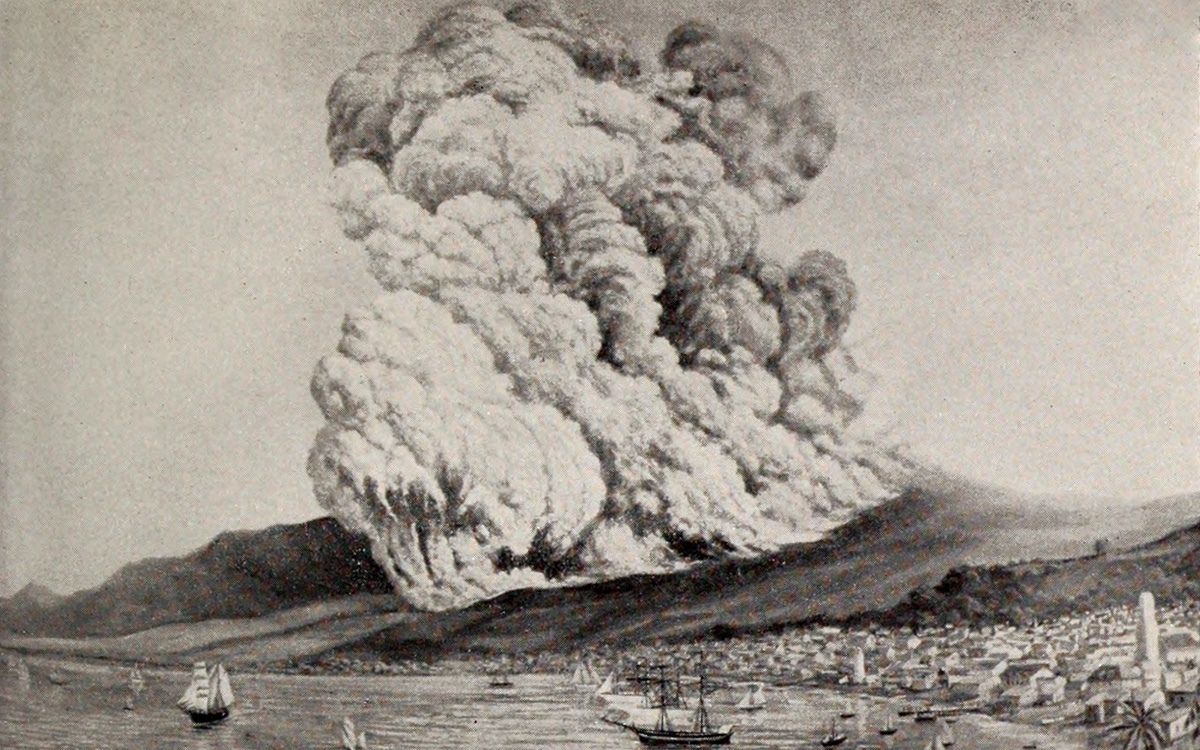
Internet Archive Book Images
On May 8, 1902, on the Caribbean island of Martinique, Mt. Pelée erupted, killing more than 30,000 people in the city of St. Pierre within minutes. It was a devastating event, notable as the worst volcanic disaster of the 20th century (and so far, the 21st).
When one thinks of volcanoes, images of smoke and oozing molten lava come to mind. But what doomed the city of St. Pierre was something unfamiliar to scientists at that time: pyroclastic flow. A pyroclastic flow, composed of hot gases, ash and rock, erupts from the volcano with tremendous power and speed, flattening and burning everything in its path. When the end finally came, it must have been an agonizing, horrific death for those in the flow’s destructive path.
The warning signs—fumes, smoke, rockslides, lava—were there for weeks. In April, Clara “Louisa” Prentis, wife of U.S. Consul Thomas Prentis, wrote a letter to her sister in Massachusetts, describing how the whole population of the city was on alert, fearing that Mt. Pelée “had taken into its heart to burst forth and destroy the whole island.” Mrs. Prentis had a close-up view of the events unfolding, as the rear windows of her residence faced Mt. Pelée, looming just four miles away. Unfortunately, the location of the U.S. consulate and the failure to evacuate in time would doom the entire family—Consul and Mrs. Prentis, and their young daughters, Louise Lydia and Christiana Hazel—as well as Vice Consul Amédée Testart.
Given the magnitude of the event, it is interesting that most people outside Martinique have never heard of the eruption of Mt. Pelée and the destruction of St. Pierre. Indeed, it was a somewhat random Google search—I was looking for “consuls in the Caribbean” as part of my interest in consular history—that led me to Thomas Prentis and, thus, the eruption of the volcano. At the time, I was serving as consul general to Barbados, and the island of Martinique was within my area of responsibility. My interest thus piqued, I set out to learn more about Prentis, his life and his fate.
No Stranger to Bad Luck
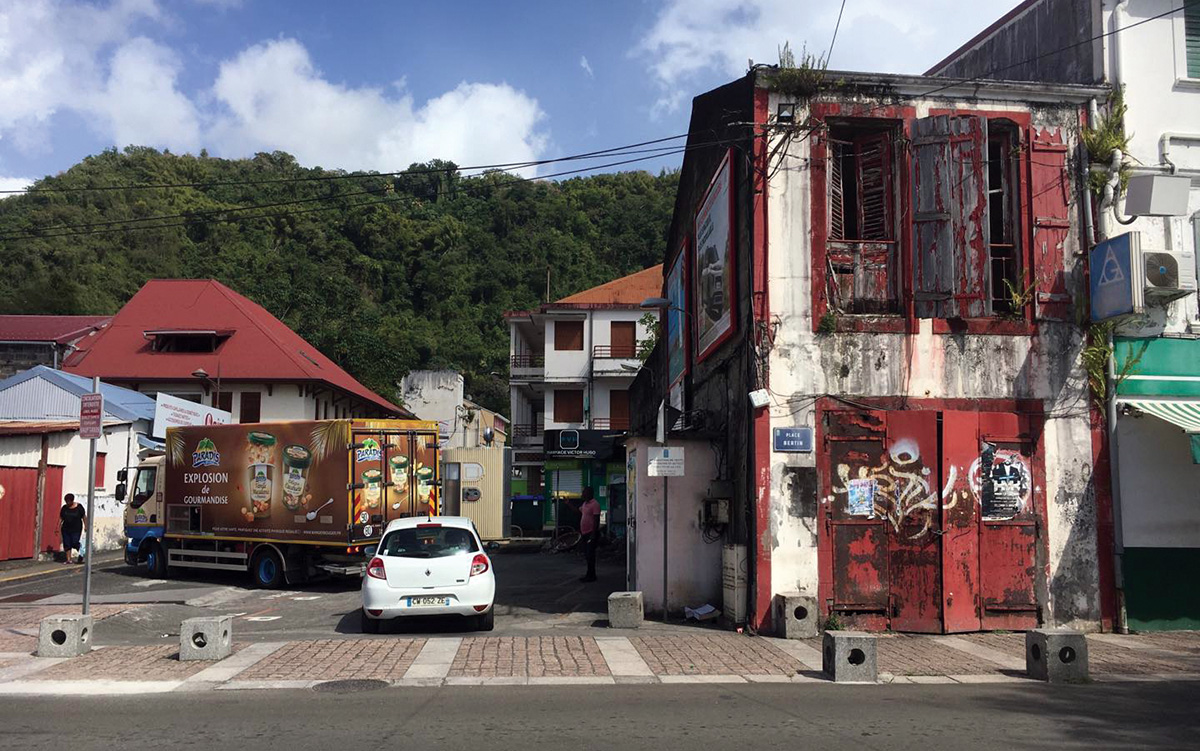
Here is where U.S. Consulate St. Pierre was located before its destruction in the 1902 eruption.
Sdr. Sebastien Perrot-Minnot, University of West Indies, Martinque
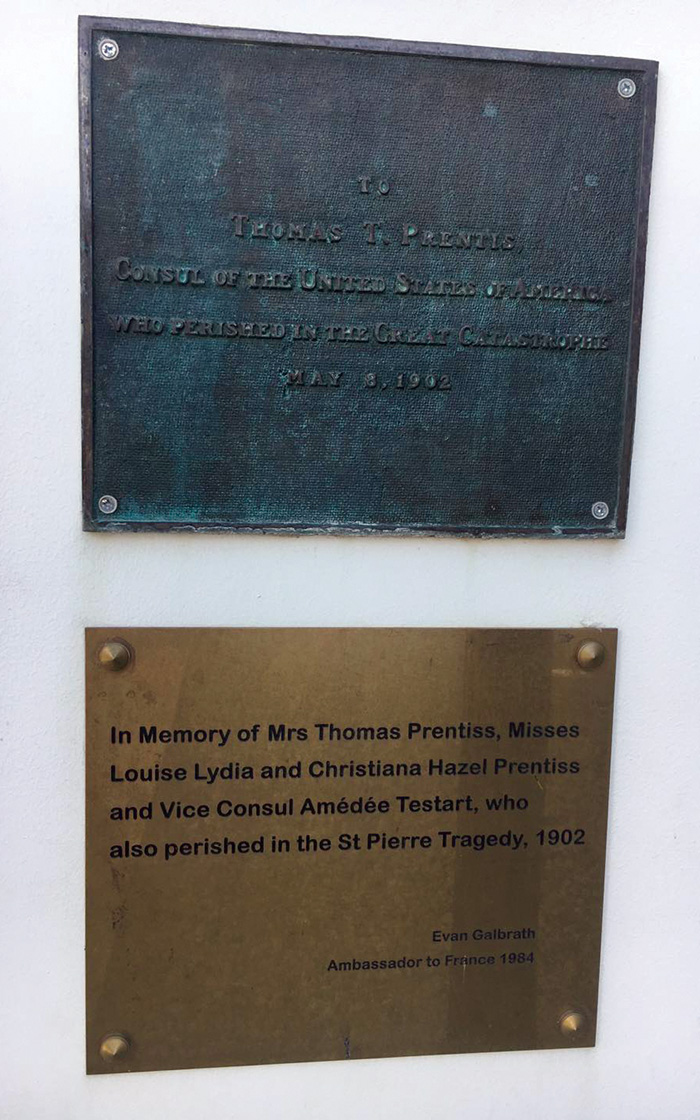
Plaques in memory of Consul Thomas Prentis (top) and his family and Vice Consul Amédée Testart (bottom) on the exterior wall of Mémorial de la Catastrophe de 1902 – Musée Frank A. Perret, the volcanological museum in St. Pierre.
Sdr. Sebastien Perrot-Minnot, University of West Indies, Martinque
Thomas Prentis was born in 1844 in Michigan, but his family soon relocated to Vermont where Thomas lived the simple life of a farm boy. Later, after the Civil War, he was engaged in the hotel business. At some point, possibly due to the business and civic connections he forged as a hotel manager, he earned the support of Senator George Edmunds (R-Vt.), who helped him secure his first appointment as consul, in December 1871, to Mahé in the Seychelle Islands. Prentis remained in the Seychelles for nine years, marrying Louisa Frye, the daughter of an American sea captain, there. Prentis was later transferred to Port Louis, Mauritius, where he served for 14 years.
Thomas Prentis was no stranger to bad luck, if two incidents befalling him during two separate home leaves are any indication. The first occurred in August 1877. On leave from his position in the Seychelles, Prentis traveled with his family to Waitsfield, Vermont, to visit his father. Their arrival caused quite a scene, because they brought with them a servant and a considerable amount of treasure acquired during their travels. According to the Aug. 22, 1877, edition of the Argus & Patriot, “their costly goods and baggage fairly surprised the neighbors … as they were unloaded in front of his father’s residence from the extra wagon that brought them into the valley. Among the goods were 100 silk parasols, a large number of silk dress patterns, 200 canes cut from different kinds of wood that grew upon the Island, [and] also numerous curiosities of various kinds.”
During their stay, the consul and his wife attended church and “outshone all in elegance and style of dress.” According to the now-defunct Vermont newspaper, Mr. Prentis explained that his wealth derived from his wife, the “daughter of a millionaire, who had given them $8,000 to make their trip.” It is possible that Louisa’s father, the ship captain, had amassed such wealth from commercial dealings in the Seychelles.
In retrospect, perhaps Prentis should have forgone the ostentatious displays, however, and kept a lower profile. Instead, his presence in Vermont drew the attention of one Mrs. Sarah Thayer, a widow of about 35 years of age, whom the papers described as of small means, who worked for a living and who was highly esteemed in the community and of fine appearance. She also, apparently, had a long memory and held a grudge.
It seems that prior to departing in 1871 for his assignment in the Seychelles, Prentis had made certain promises to Mrs. Thayer; or, at the least, Mrs. Thayer had an understanding that there was an arrangement. In any event, Mrs. Thayer filed suit, claiming $5,000 in damages for breach of promise. Prentis was arrested; and when his father refused to bail him out, he turned to his brother and two friends for the money.
Mrs. Prentis had a close-up view of the events unfolding, as the rear windows of her residence faced Mt. Pelée, looming just four miles away.
No doubt anxious to settle the matter so that he could resume his consular duties, he eventually came to an agreement with Mrs. Thayer, and the suit was dismissed. One account has Prentis paying the aggrieved widow $1,000; but another, in the Argus & Patriot of Dec. 12, 1877, disputes this, stating that although Prentis called on Mrs. Thayer, the discontinuance of the suit “was entirely voluntary upon the part of Mrs. Thayer,” and no money was paid. The official court record indicates that the suit was “discontinued, without cost.”
The other incident occurred in December 1884, while Prentis was on leave from his assignment in Port Louis, Mauritius. During a visit to New York City, he engaged in a pub crawl and, according to The New York Times, eventually ended up in a dive bar on Front Street. After downing several drinks, he met four young men who regaled him with tales of the city and offered to show him around the metropolis. As the evening wore on, the hapless consul became quite inebriated, and his new friends took advantage of his condition, relieving Prentis of a gold watch and chain, $67 in cash and a solitaire pin. There is no honor among thieves, however, and a quarrel ensued over the plunder, resulting in the death by stabbing of one of them. Some of the stolen property was later found on one Thomas Tobin, a newsboy.
The Posting to Martinique
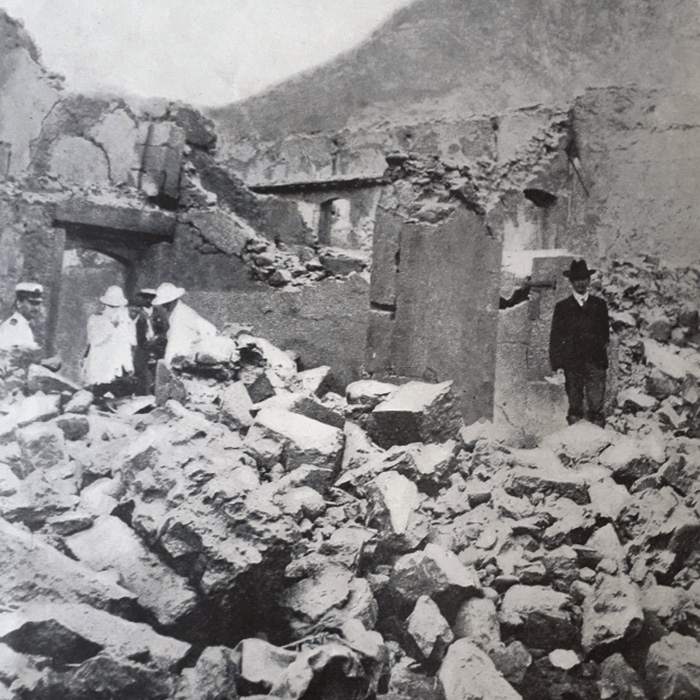
The ruins of the U.S. consulate following the 1902 eruption.
Complete Story of the Martinique and St. Vincent Horrors, 1902
Mr. Prentis’ posting to Martinique was borne out of a bureaucratic muddle within the context of the old patronage system that governed consular appointments. In 1900 Prentis was serving in Rouen, France, when, for reasons that are unclear, he began to seek another assignment, this time in a tropical setting. It is possible that health reasons were a factor. Prentis had a heart condition, which he had developed while in active military service in the Union Army during the Civil War. He had served as a sharpshooter with the 2nd Regiment out of Vermont. Although the exact nature of his heart condition is lost to history, its effects were enough to merit his discharge, on health grounds, from the U.S. Army in September 1864.
In any event, Prentis was seeking a change, and had a powerful ally in Massachusetts Republican Senator Henry Cabot Lodge, who began actively lobbying Secretary of State John Hay on his constituent’s behalf. What followed was an interesting correspondence—documented in the September 1954 issue of The New England Quarterly—between Lodge and Hay as the latter diligently tried to secure a posting for Prentis. Hay first offered Iquique; but when he subsequently informed Lodge that the city was in faraway Chile (and not in Mexico, as the senator first believed), and that the “fees are so very little better than Rouen that the increase would, I should think, not compensate for the expenses of the journey and the remoteness of the place,” Lodge advised Prentis against pursuing the assignment.
On May 1, 1900, Hay informed Lodge that the president would nominate Prentis for Batavia, Java, instead. After a brief respite in America, Prentis departed for Batavia on August 14, 1900, via France, where he reportedly attended the Paris Exposition. At some point in the journey, he was joined by an adult son, also named Thomas, who would accompany him to Batavia and take a position there with the Standard Oil Company. But there was a mix-up: Secretary Hay was not aware of it, but President McKinley had already appointed another man—a Mr. Rairden—as consul to Batavia.
Mr. Prentis’ posting to Martinique was borne out of a bureaucratic muddle within the context of the old patronage system that governed consular appointments.
On learning of this, the Secretary transferred Prentis to Martinique, without seeing fit to alert Senator Lodge. Lodge was understandably upset when he eventually learned of the turn of events, but Secretary Hay assured him that Martinique “is a much better place than Batavia in all respects, and I did not dream it would be objectionable to Mr. Prentis or his friends … and certainly see no hardship in giving Mr. Prentis the promotion, whether you call it a promotion from Batavia with a salary of $1,000, or a promotion from Rouen with no salary at all. It was so clearly to his advantage that I did not see the necessity of referring the matter to you.”
Senator Lodge’s concerns over the hardship caused Mr. Prentis were eventually assuaged when Hay agreed to cover the consul’s travel expenses from Batavia to Martinique. And thus a bureaucratic snafu changed the destiny of our star-crossed consul, placing him in the path of volcanic destruction.
Disaster Strikes

The U.S. consulate in Martinique in about 1900.
Complete Story of the Martinique and St. Vincent Horrors, 1902
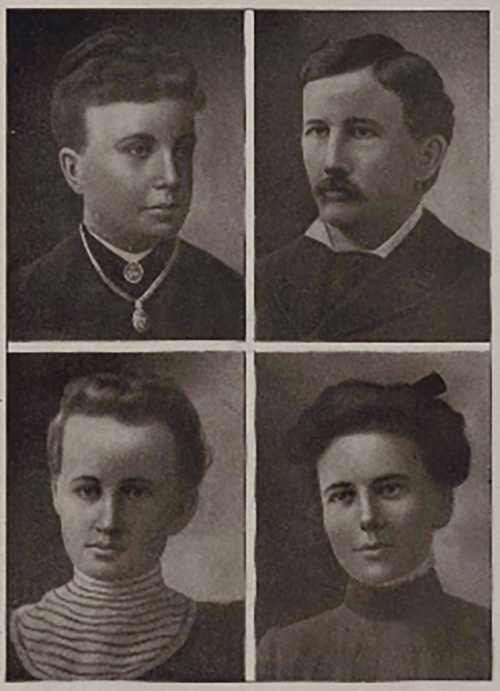
Consul Thomas Prentis, his wife and their two daughters all perished in the 1902 eruption of Mt. Pelée.
Complete Story of the Martinique and St. Vincent Horrors, 1902
Martinique had been one of the first places where the young United States established a consular presence. On June 4, 1790, President George Washington named Fulwar Skipwith as consul to the island. More than a century later, at the time of Prentis’ appointment, the French island was still an important commercial hub in the Caribbean, and the city of St. Pierre was considered “the Paris of the Antilles.” Ernest Zebrowski, who wrote one of the definitive accounts of the Martinique disaster in his book, The Last Days of St. Pierre: The Volcanic Disaster That Claimed Thirty Thousand Lives (Rutgers University Press, 2002), describes the city as the “gem of the West Indies” and discusses the significant American financial interest in the various commercial enterprises in the city, which included, of course, rum and sugar. (The United States closed its consulate in Martinique in 1993, establishing instead a consular agency whose consular agent reports to Bridgetown, Barbados.)
In the weeks preceding the ultimate cataclysmic eruption, Mt. Pelée had issued warning signs. Why didn’t the Prentis family depart when they could? They surely were aware that the volcano posed a danger. On May 3, Mrs. Prentis wrote again to her sister, describing the smell of sulphur in the air, the fire and lava emitting from the volcano. “Everybody is afraid,” she wrote, but later on in the letter reveals that her husband assured her there was no immediate danger and that a ship was in the harbor that could whisk them to safety should the situation deteriorate further.
It is probable that Prentis thought they would have time in such a scenario because, like others, he was unfamiliar with the rapid, devastating effects of a pyroclastic surge. In another excellent book about the tragedy, La Catastrophe: The Eruption of Mount Pelée, the Worst Volcanic Disaster of the 20th Century (Oxford University Press, 2002), Alwyn Scarth reveals how the population of St. Pierre had a vague memory of previous “puny eruptions” that had resulted in minimal damage. These eruptions, writes Scarth, “induced a false sense of security in the minds of the people of Martinique.”
According to contemporary newspaper reports, the United States dispatched two ships, the cruiser Cincinnati and the naval tug Potomac, to assist with relief efforts. And on May 20, 1902, crews from the two U.S. warships along with personnel from the British cruiser Indefatigable, came ashore to recover the remains of Prentis, which had been discovered in the ruins of the U.S. consulate. Unfortunately, the remains of his wife and daughters were not found, or were so badly burned as to be beyond recognition. Bearing silver coffins, the crews also were in search of the body of James Japp, the British consul.
Ernest Zebrowski Jr. offers a vivid account of the rescue mission, which was conducted as Mt. Pelée continued to belch out smoke and ash to such an extent that it imperiled the brave rescuers. Both bodies were recovered, but in a mad scramble back to the ships as loud booms and fire emanated from the volcano, Japp’s body was “unceremoniously” dropped, never to be recovered. The crews managed to get Prentis’ coffin aboard the Potomac, which then made haste to escape the smoke and ash. According to contemporary newspaper reports, Thomas Prentis’ body was transported to Fort-de-France where, on May 22, a funeral took place, with the commander of the Cincinnati officiating. He was buried “under an acacia tree” in a cemetery located “back of Fort-de-France.”
I had the opportunity during my tour in the Eastern Caribbean to go to Martinique, and during two visits there I made inquiries into the whereabouts of Consul Prentis’ grave. Our consular agent, Leah McGaw, and I searched the main cemetery in the capital and submitted requests to the French government seeking information, all to no avail. I also contacted some of Prentis’ ancestors via Ancestry.com, none of whom knew where exactly he was buried.
It is possible that the rescue mission and recovery of Prentis’ remains never happened. Recently, colleagues working on the Consular Affairs History Project put me in contact with Dr. Sébastien Perrot-Minnot, a professor at the University of the French West Indies in Martinique, who has researched the disaster and written about the history of the U.S. diplomatic and consular presence on the island. He brought to my attention this message that Louis H. Aymé, U.S. consul in Guadeloupe and acting U.S. consul in Martinique in May and June 1902, sent to the Department of State, on July 21, 1902: “It is a matter of deep regret to me that I could not succeed in rescuing the remains of our late consul nor any of the archives of the consulate. All were buried under many feet of volcanic mud and ejecta.”
And so, it seems, ends the quest for our unlucky colleague, Consul Thomas Prentis. His name is engraved, along with his vice consul, Amédée Testart, on the AFSA Memorial Plaques in the State Department lobby.




